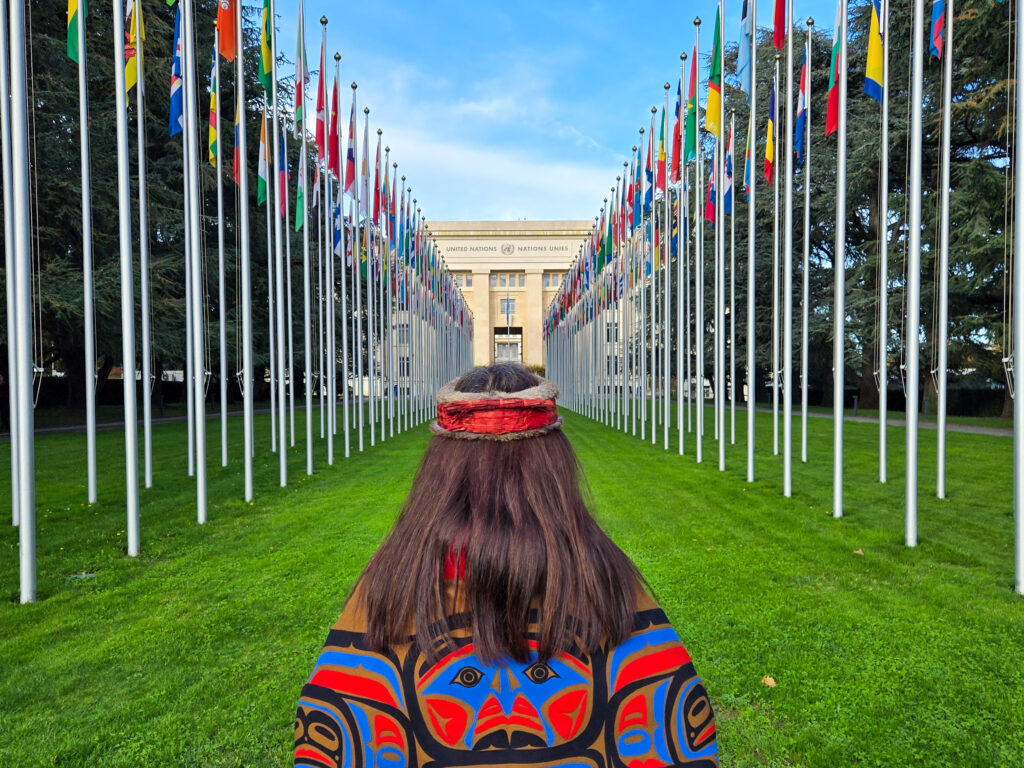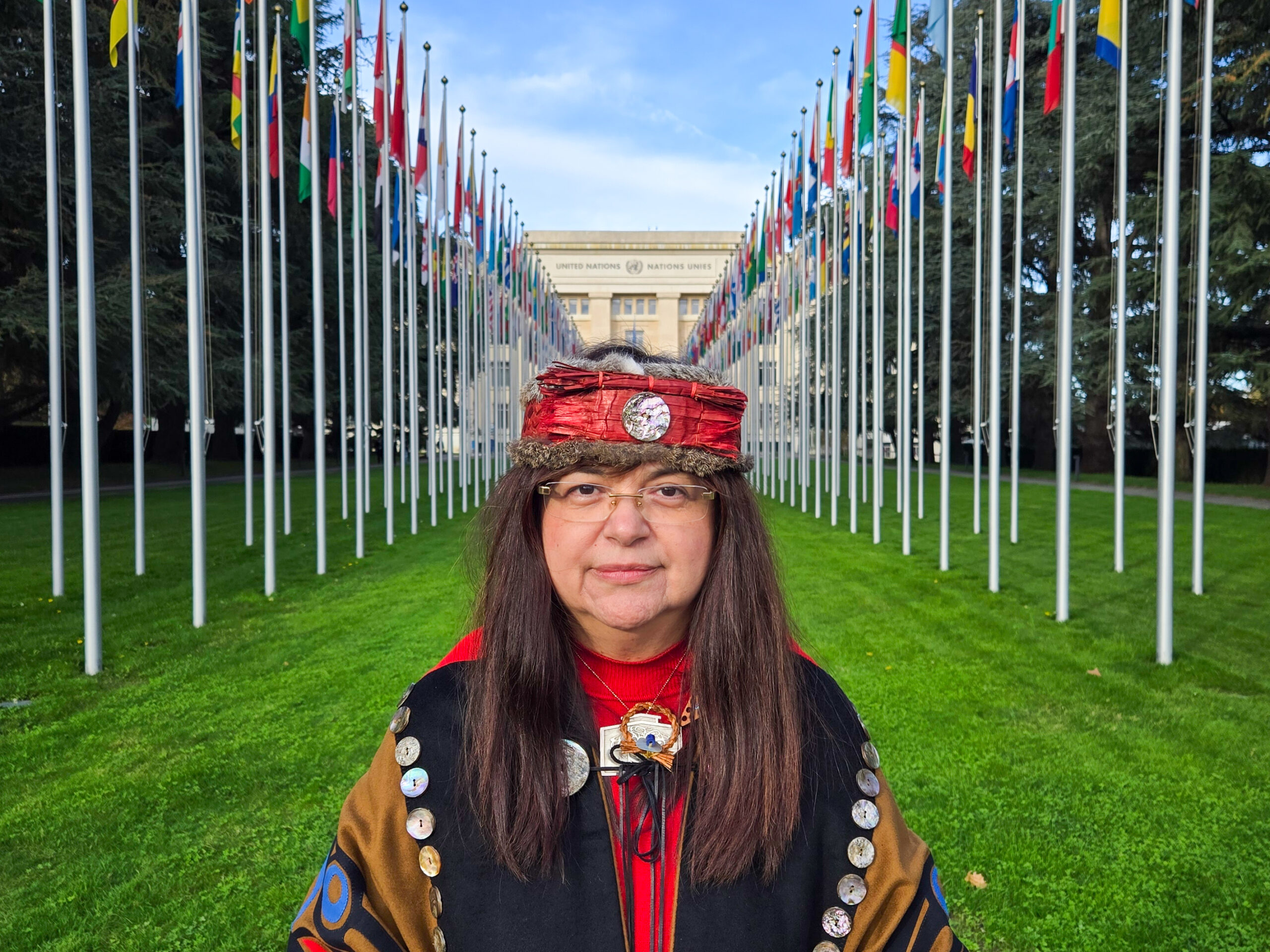K̓áwáziɫ Marilyn Slett is familiar with the international stage. As the elected chief of the Haíłzaqv (Heiltsuk) Nation, Slett has advocated for Indigenous rights across the country and across the globe. As she made the long journey from her coastal village of Waglisla (Bella Bella) to Geneva, Switzerland, she got deeply emotional, reflecting on the contents of the statement she was delivering to a United Nations Committee on ongoing issues of sexism and discrimination.
On October 14, Slett attended the 89th session of the Committee on Elimination of Discrimination Against Women (CEDAW), where the Committee reviewed Canada for its compliance with the Convention on the Elimination of all forms of Discrimination against Women and met with Indigenous organizations and women’s rights NGOs from across the country. Slett was entrusted with delivering a joint statement to summarize concerns with the ways in which the Indian Act has discriminated against women and their descendants, including members of her family and community.
“I got emotional on the plane on the way to Geneva… reading and thinking about families, women and the ongoing discrimination,” says Chief Slett over the phone, a few weeks after the event. “We wanted to make sure we were clear in our messaging… I felt a lot of weight and responsibility.”
Also attending the UN Committee session from Canada were members of the Indian Act Sex Discrimination Working Group, including the Union of B.C. Indian Chiefs, the Ontario Native Women’s Association, the Feminist Alliance for International Action, Quebec Native Women and leading plaintiffs in the court and UN petitions that have challenged Indian Act sex discrimination.

Second Generation Cut-off
A major concern Slett and others brought to the convention regarding Section 6(2) of the Indian Act, is known as the “Second Generation Cut-off.” This section states that if a person has a child with a non-registered person, their children will not have the right to Indian status, therefore depriving them of their rights and entitlements.
“My grandchildren are impacted by the second-generation cut-off rule that exists today. It means they’re not recognized as Haíłzaqv members by Canada and aren’t eligible for status,” Slett says. “We know that my children and grandchildren are Haíłzaqv, they have a long and clear lineage, recognized in our community by our laws, but discriminated against by Canada.”
According to a University of Calgary report that evaluated policy alternatives to assist in resolving registration issues, the result of the second-generation cut-off means a significant decline in people holding status, leading to the eventual legal extinction of First Nations within three to four generations. The report states that the Act contains colonial laws aimed to intentionally eliminate First Nations culture by assimilation into Canadian society.
Slett says 20 percent of her community are impacted by the second-generation cut-off, which means they can’t pass on their status on their own — they must be partnered with someone else who also holds status. Canada has recently released Community Specific Data Sheets which outline the percentage of section 6 status holders by community. Many are upwards of 40 to 50 per cent, demonstrating that legal extinction is a very imminent threat.
Every Nation across Canada has members that are impacted… this will lead to the legal extinction of status people, within three to four generations. This is a very real harm.”
The Indian Act Sex Discrimination Working Group, which provides a number of recommendations for the Government of Canada, called on Canada to end sex-discrimination and repeal the rules regarding the transmission of status. Recommendations include replacing the two-parent rule with a one-parent rule, which is the standard for transmission of Canadian citizenship.
‘Tool of Forced Assimilation’
The Indian Act discriminates against First Nations women and children on the basis of sex, race and family status, according to a UBCIC press release.
“Sex discrimination in the Indian Act has been an effective tool of forced assimilation for 148 years, between 1876 and 1985, by legally defining thousands of First Nations women and their children as non ‘Indian’ if they ‘married out’. By contrast, First Nations men who married out endowed their ‘non-Indian’ wives and children with Indian status,” the release states.
In 2019, Canada brought into force a provision of Bill S-3 that eliminated the core of the sex discrimination that refused status to women who “married out.” At the time, the Government of Canada estimated this change would make between 270,000 and 450,000 women and their descendants newly eligible for the status that had been denied to them. Data from Indigenous Services Canada, in June 2024, shows that only 55,804 individuals have been registered. The process to register for status is lengthy (six months to two years), complicated and lacks adequate support.
Further, the Indian Act contains a legal bar, introduced in 1985, to compensation for First Nations women and their descendants for the harms caused by sex discrimination. The working group says the bar constitutes “blatant sex discrimination,” contrary to the right to remedy and reparation under CEDAW, to the equality provision (s.15) of Canada’s Charter of Rights and Freedoms, and the right of Indigenous women to redress for forced assimilation, guaranteed in Article 8(2)(d) of the United Nations Declaration on the Rights of Indigenous Peoples (UNDRIP). According to The Working Group, First Nations women are entitled to compensation for harms done and benefits denied.
First Nations women are entitled to remedy and reparations in the form of restoration of status and membership, apology, memorialisation of the women who have been leaders in challenging the discrimination, and public education regarding the history of sex discrimination and its impacts on Indigenous women, their descendants and their Nations.”
They recommend that Canada remove the bars to compensation and amend Bill C-38 to include a provision to design a mechanism permitting women and their descendants to claim and obtain compensation. They also recommend Canada provide full reparations for 148 years of sex discrimination, including compensation, apology, and public education on sex discrimination in the Indian Act.

Cycles of Disadvantage
Following the trip to Geneva, the CEDAW Committee released its concluding observations where they express their “deep concern” to ongoing gender-based discrimination against Indigenous women and girls. They express particular concern for the second-generation cut-off rule, the ongoing lack of action to reinstate women and their descendants, the legal provisions of the State preventing reparations for human rights violations related to the Indian -Act and the low registration of new memberships.
“The Committee is worried about insufficient support for Indigenous women to overcome barriers to employment and entrepreneurship, boost participation in traditional economies, and access workplace vocational training and education within their communities,” the report states. “These gaps in policy and support systems hinder the ability of Indigenous women to fully participate in economic and educational opportunities, potentially perpetuating cycles of disadvantage.”
The Committee recommends that Canada amend section 6 of the Indian Act to remove status categories, as well as “any other legal provisions that do not recognize the equal right of women and men to transmit their status to their children,” to review records to grant status to women and their descendants who were previously denied, to repeal all domestic legal provisions restricting access to reparations for the violation of human rights and to conduct educational outreach campaigns on the subject.
‘We Always Had Our Laws’
Meanwhile, many Nations across the country continue to practice and uphold their own laws, practicing custom adoptions and addressing issues of citizenship and membership through their own unique legal frameworks. Nations continue to work towards self-determination, defining their own rights and title, governance, including issues of membership. Chief Slett’s Nation has been working for over 15 years to strengthen their Constitution, which is meant to reflect Haíłzaqv legal orders and governance. According to the Nation’s website, the Constitution will articulate and outline the core principles by which the Nation will be governed and organized.
Our Haíɫzaqv Constitution is rooted in our Ǧvi̓ḷás (Laws), Ɫáxvái (Jurisdiction), and Núyṃ́ (History), and it articulates our foundational governance principles.”
“We have always had our Haíłzaqvlaws, our ǧvi̓ḷás, since the beginning of our people, for thousands and thousands of years,” Chief Slett says. “The Constitution reflects how we govern and live our lives as Haíłzaqv people. We have our hereditary chiefs, our Yímas, our Mnúyaqs council, our Women’s Council and our elected leadership, working together as joint leadership for our community.”
Haíłzaqv laws differ from Canada’s laws, in big and small ways, especially regarding citizenship, membership, and family connections and ties, Slett says.
“Our Constitution is about our self-determination as Haíłzaqv people. My grandchildren were custom adopted in our Big House, in accordance with our ǧvi̓ḷás, recognized by our community as Haíłzaqv citizens,” Slett says. “Through our own ǧvi̓ḷás, we can recognize, embrace and acknowledge our members, bring them back into the community, and uplift them as members of our society. Communities are all at different places with their work in self-determination, it has been and will be a long road, but it’s something we need to do.”
Read More:
- See submissions to the CEDAW Committee by the Working Group, the UBCIC and the Ontario Native Women’s Association.
- Read UBCIC’s resolution, calling on Canada to respect First Nations’ rights to self-determination over citizenship laws.
- Read the Senate Standing Committee on Aboriginal Peoples’ report ‘Make it Stop! Ending the remaining discrimination in Indian registration.
- Read Canada’s Community Specific Data Sheets on Second Generation Cut-off.

